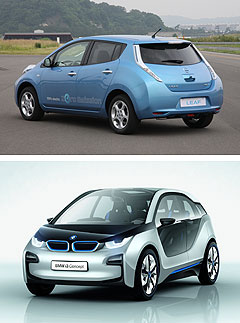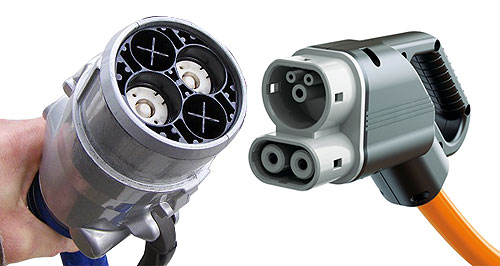Make / Model Search
News - General News - Electric VehiclesAustralia ponders EV plug standardDisconnect: Two electric vehicle fast charging plugs have been released by consortiums from Japan (left) and Germany/US. Global car-makers split on electric car charge protocols, causing a quandary for Oz8 May 2012 THE Australian motor industry’s peak body is working with Standards Australia to try to identify a harmonised fast-charging electric vehicle plug standard for Australia to avoid a “VHS-Beta” divide in technology. American and German motor manufacturers this week jointly unveiled their choice of fast-charge plug system – developed with the International Society of Automotive Engineers – at the Electric Vehicle Symposium (EVS26) in California. However, this plug is incompatible with a plug adopted by a consortium of Japanese car-makers who have pioneered mass-produced electric vehicles. Consequently, on one side we have the Japanese group of Nissan, Mitsubishi, Subaru and Toyota with their ChaDeMo system, and on the other the German-US alliance of BMW, Chrysler, Daimler, Ford, General Motors and the Volkswagen Group – including Porsche and Audi – with the SAE Combined Charging System. Australia and many other markets face the prospect of both consortiums wanting to introduce their protocols on vehicles to be sold here, posing a quandary for Australian consumers and charging companies such as Better Place and ChargePoint. The issue concerns only the fast-charging public stations, as home chargers using either 10amp or 15amp connections can use standard fittings already available in Australia. The fast-charging plug needs to not only deliver large volumes of power – sufficient to charge car batteries in as little as 15 minutes – but also “speak” to the power grid via a smart meter system. Australia’s Federal Chamber of Automotive Industries (FCAI) this week confirmed that it was working with Standards Australia to determine a standardised system in an effort to avoid consumer confusion and fast-charge station complication. FCAI technical director James Hurnall said the plug choice was one of a number of standardisation issues concerning the introduction of EVs. He said differing plugs had emerged overseas, but efforts were being made both globally and within Australia towards harmonisation. “We are in the hands of what is happening overseas, but by the same token we are working with Standards Australia to develop a standard as much as possible, so that we don’t have a difference in plugs that is going to impact on people who wish to purchase an electric vehicle,” he said.  Left: The Japanese Nissan Leaf EV and the German BMW i3 concept. Left: The Japanese Nissan Leaf EV and the German BMW i3 concept.Mr Hurnall said the standardisation process also involved the public EV charging companies, and FCAI’s EV working group – a committee of motor company technical experts. “We will influence them as much as we can,” he said. “As we go down this path, there will be lots of changes.” The German car-makers joined with America’s Big Three – GM, Ford and Chrysler – to unveil their choice of plug in Los Angeles this week. The single-plug combined charging system integrates one-phase AC-charging, fast three-phase AC-charging, DC-charging at home and ultra-fast DC-charging at public stations into one vehicle inlet. “This will allow customers to charge at most existing charging stations regardless of power source, and may speed more affordable adoption of a standardised infrastructure,” the companies say. The companies said the Combined Charging System was developed for all international vehicle markets and created “a uniform standard with identical electrical systems, charge controllers, package dimensions and safety mechanisms”. “The system maximises capability for integration with future smart grid developments through common broadband communication methods, regardless of the global location of the charging system,” the joint statement said. “The combined charging approach will reduce development and infrastructure complexity, improve charging reliability, reduce the total cost-of-ownership for end customers and provide low maintenance costs.” They said the European Automobile Manufacturers Association had selected the Combined Charging System as its AC/DC-charging interface for all new vehicle types in Europe beginning in 2017. However, manufacturers who have already backed the system are expected to have vehicles designed for the plug by as early as 2013. Interestingly, the Californian announcement did not include European car-makers outside Germany, such as Fiat, Renault, PSA Peugeot-Citroen and Volvo, among others. The Japanese Chademo system – an abbreviation of Charge de Move – was developed with Tokyo Electric Power Company to deliver Level 3 DC fast charging, along with a data protocol call Can-bus. The Nissan Leaf and Mitsubishi i-MiEV electric cars are already designed to use this system.  Read more |
Click to shareGeneral News articlesResearch General News Motor industry news |










Facebook Twitter Instagram